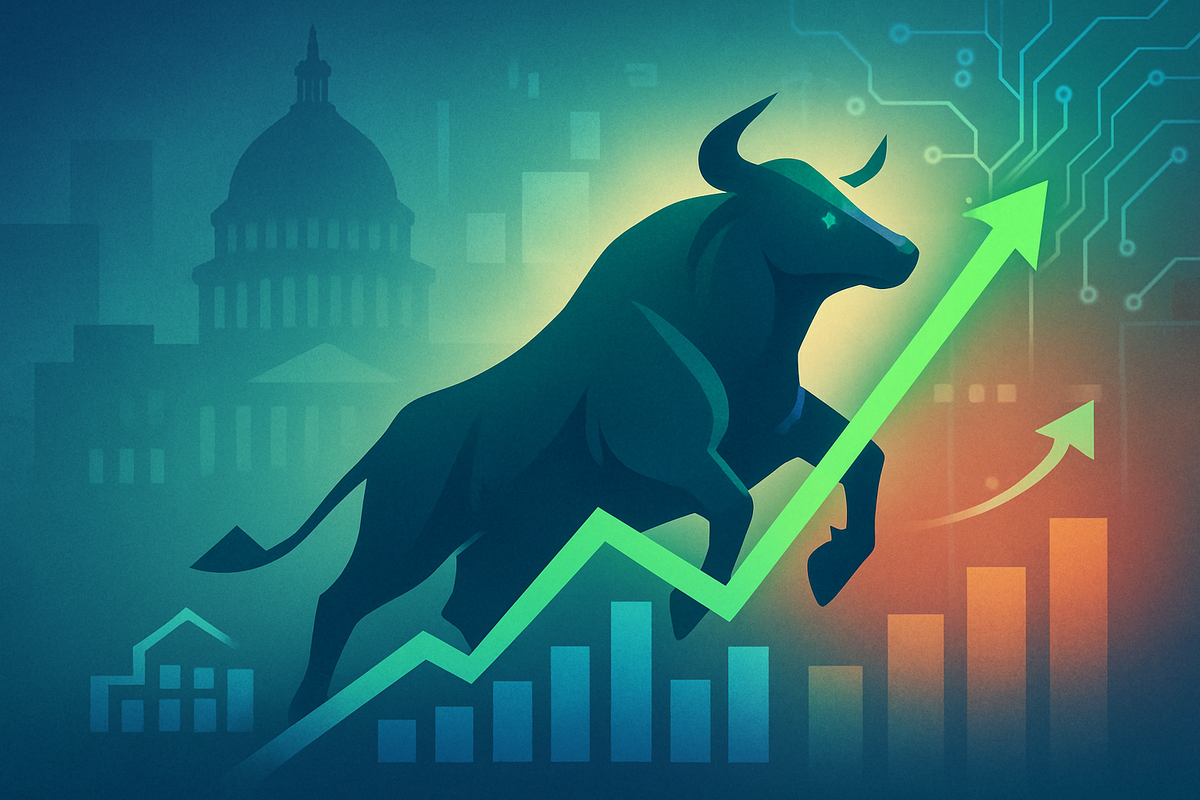
As of October 20, 2025, Wall Street is experiencing a significant uplift, with major stock indices registering notable gains at the start of the week. This surge in market optimism is primarily fueled by two powerful catalysts: the promising outlook for third-quarter corporate earnings and growing hopes for an imminent resolution to the protracted government shutdown. Despite the shutdown entering its third week, investors appear to be shrugging off immediate political gridlock, instead focusing on the underlying strength of corporate America and the potential for a return to normalcy.
The market's resilience, even amidst political uncertainty, underscores a prevailing sentiment that strong economic fundamentals and anticipated monetary policy adjustments will ultimately prevail. While the ongoing shutdown introduces an element of short-term volatility and delays crucial economic data, the overarching narrative is one of cautious optimism, with investors positioning themselves for continued growth driven by robust corporate performance and favorable macroeconomic conditions.
Market Defies Political Gridlock as Strong Earnings and AI Hopes Fuel Rally
The week of October 20, 2025, commenced with a palpable sense of optimism on Wall Street, as major U.S. stock indices demonstrated robust gains. The S&P 500 (INDEXSP:.INX) climbed 0.6%, the Nasdaq Composite (NASDAQGS:.IXIC) advanced 0.8%, and the Dow Jones Industrial Average (INDEXDJX:.DJI) rose 0.4% at the opening bell. These positive movements extended a bullish trend from the previous week, where all three major indices had closed up by approximately 2%. This market resilience is particularly noteworthy given the backdrop of an ongoing federal government shutdown, now in its 20th day.
The primary catalyst for this market buoyancy is the strong showing in the third-quarter corporate earnings season. With roughly 12% of S&P 500 companies having reported, an impressive 86% have surpassed analysts' earnings per share (EPS) estimates. The blended earnings growth rate for the S&P 500 is projected at a healthy 8.5%, an increase from the 7.9% forecast at the season's outset. This robust performance, particularly from major U.S. banks in the preceding week, has instilled confidence among investors, who are now eagerly awaiting reports from tech giants like Tesla (NASDAQ: TSLA), Netflix (NASDAQ: NFLX), and Intel (NASDAQ: INTC), alongside consumer staples stalwarts such as Coca-Cola (NYSE: KO) and Procter & Gamble (NYSE: PG). The enduring enthusiasm around artificial intelligence (AI) advancements also continues to fuel growth expectations across various sectors, reinforcing beliefs in long-term profitability.
The government shutdown, which began on October 1, 2025, after Congress failed to pass appropriations legislation, has unfortunately not seen a resolution by October 20. This protracted impasse, now the third-longest in U.S. history, stems from deep partisan divisions over federal spending, foreign aid, and health insurance subsidies. Key figures involved in this political deadlock include President Donald Trump, House Speaker Mike Johnson, Senate Majority Leader John Thune (R-S.D.), and House Minority Leader Hakeem Jeffries (D-N.Y.). Speaker Johnson has maintained a firm stance against negotiating with Democrats amidst what he terms a "hostage situation." The shutdown has led to the furlough of approximately 900,000 federal employees and left another 700,000 working without pay, causing significant hardship and delaying critical economic data releases.
Despite the political gridlock and its tangible impacts, the market's initial reaction has been characterized by "relative calm" and "resilience." Analysts largely view the shutdown as a "political pothole rather than an economic abyss," suggesting investors perceive it as a temporary political issue with limited fundamental economic consequences. While gold prices (COMEX:GC00) have surged nearly 3% to $4,335 per ounce, reflecting its traditional role as a safe-haven asset, the broader equity market has remained surprisingly unfazed. The Cboe Volatility Index (CBOE:VIX) has stayed above 20, indicating some underlying investor uneasiness, but this has not deterred the overall upward trajectory driven by corporate earnings and easing U.S.-China trade tensions.
Sectoral Shifts: Winners and Losers Emerge Amidst Earnings Strength and Shutdown Strain
The current financial landscape, characterized by robust corporate earnings juxtaposed with a persistent government shutdown, creates a bifurcated impact across various industries and public companies. While strong earnings generally signal a healthy underlying economy and boost investor confidence, the ongoing shutdown introduces significant headwinds for specific sectors, leading to a clear delineation of potential winners and losers.
Companies heavily reliant on government contracts, particularly in the defense, IT services, and broader government services sectors, are facing considerable challenges. Major defense contractors such as Lockheed Martin (NYSE: LMT) and Boeing (NYSE: BA), along with IT service providers like Science Applications International (NYSE: SAIC), are experiencing delays in new contract awards and payments, and project disruptions due to furloughed oversight personnel. Small businesses, which often rely on Small Business Administration (SBA) loans, are also severely impacted as loan approvals are halted, cutting off vital funding. This uncertainty around future government spending and contract continuity is likely to suppress their stock prices and hinder operational outlooks, potentially leading to project backlogs and even employee attrition as workers seek more stable employment.
Conversely, sectors largely insulated from government spending and regulation, and those benefiting from strong consumer demand or independent market trends, are poised to thrive. Consumer staples companies, like Coca-Cola (NYSE: KO) and Procter & Gamble (NYSE: PG), which produce essential goods, tend to be more resilient as consumer demand remains stable irrespective of political turmoil. Similarly, utility companies provide essential services with stable revenue streams. Large, diversified technology companies with limited government reliance, such as Apple (NASDAQ: AAPL) or those heavily invested in the AI boom like Nvidia (NASDAQ: NVDA), are also expected to continue their strong performance, driven by global demand for their products and services, cloud computing, and digital advertising. Their robust cash reserves and international exposure provide a buffer against domestic government disruptions, making them attractive to investors seeking stability and growth.
Furthermore, specific sub-sectors within healthcare that are less dependent on federal funding or immediate regulatory approvals, focusing instead on private insurance markets or elective procedures, might also see continued growth, especially if strong corporate earnings reflect high demand for their innovative medical technologies. Companies with significant international operations are better positioned to offset any domestic slowdowns caused by the shutdown with overseas growth, further enhancing their resilience in this complex market environment. The market's current dynamic thus favors companies with strong, independent revenue drivers and financial robustness, while those deeply intertwined with federal operations face a period of significant uncertainty and potential underperformance.
Wider Significance: Market Resilience, AI's Ascent, and Data Blind Spots
The current stock market rally, occurring amidst an ongoing government shutdown and driven by strong corporate earnings and technological advancements, carries profound wider significance for the global economy. This scenario underscores the market's historical tendency to prioritize fundamental corporate performance and broader economic trends over short-term political instability. The resilience demonstrated by the S&P 500 (INDEXSP:.INX), Nasdaq (NASDAQGS:.IXIC), and Dow Jones (INDEXDJX:.DJI) despite the political gridlock reinforces the notion that investors often view government shutdowns as temporary disruptions rather than fundamental economic crises. Historical data since 1990 shows that the S&P 500 has, on average, seen slight upticks during shutdowns and quick recoveries, with the 2018-2019 shutdown even witnessing a more than 10% surge in the S&P 500. This suggests that the market's conviction in corporate profitability and underlying economic strength can overshadow political noise.
This rally is deeply interwoven with two dominant broader industry trends: the accelerating Artificial Intelligence (AI) boom and easing global trade tensions. The AI revolution is identified as a "mega force" fundamentally reshaping economies, with massive capital expenditure in AI infrastructure projected to surge by 67% in 2025, reaching an estimated USD 375 billion. Major tech players like Microsoft (NASDAQ: MSFT), Meta Platforms (NASDAQ: META), and Amazon (NASDAQ: AMZN) are making significant investments, with AI's transformative power boosting efficiency, innovation, and revenue across sectors. The performance of investment portfolios is increasingly tied to AI stocks, with the "Magnificent Seven" tech giants exerting an outsized influence. Concurrently, signs of easing trade frictions, particularly with China, contribute to improved market sentiment, reducing fears of a global trade war and fostering more stable international supply chains and investment flows.
The confluence of these factors will have significant ripple effects across the economy. Competitors who are slow to embrace and integrate AI into their operations risk being outpaced by more agile, AI-powered rivals, intensifying competitive pressures across industries. Strategic partnerships focused on AI development and deployment are expected to deepen, creating new ecosystems of collaboration. While government shutdowns typically impose a minimal drag on GDP (estimated at 0.1-0.2 percentage points per week), the robust corporate earnings, the AI boom, and improved trade relations are likely to largely offset this temporary economic friction, signifying a "cautious optimism" for continued economic growth.
However, the ongoing shutdown does present critical regulatory and policy implications, primarily through the delay of essential economic data. Critical figures such as the U.S. jobs report, Consumer Price Index (CPI), and retail sales are postponed, leaving policymakers, especially the Federal Reserve, "operating a little bit blind" as they deliberate on crucial monetary policy decisions, including potential interest rate adjustments. This absence of timely and reliable official statistics complicates accurate assessments of the labor market, inflation trends, and consumer spending, potentially leading to less precise policy responses in the future and increasing uncertainty for both policymakers and investors. Despite these challenges, the market's current trajectory suggests a strong belief in fundamental economic drivers overriding temporary political impasses, a pattern consistent with historical precedents of market resilience in the face of political instability when corporate fundamentals remain robust.
What Comes Next: Navigating Uncertainty with Strategic Adaptation and Cautious Optimism
The interplay of strong corporate earnings and an enduring government shutdown sets the stage for a dynamic and potentially volatile period for the stock market. In the short term, the market is likely to maintain its current resilience, largely buoyed by robust earnings reports that continue to surpass expectations. However, this resilience could be tested by increased sectoral volatility, particularly in industries directly impacted by the shutdown. The continued delay of critical economic data, such as the jobs report and CPI, will leave policymakers, including the Federal Reserve, "a little bit blind," potentially complicating future interest rate decisions and adding an element of uncertainty. Investors may continue to seek safe-haven assets like U.S. Treasuries (INDEXFTSE:TXL), gold (COMEX:GC00), and even cryptocurrencies, as a hedge against political instability.
Looking further ahead, the long-term trajectory of the stock market will predominantly be shaped by corporate earnings, which are projected to remain strong with S&P 500 earnings growth rates for 2025 and 2026 hovering around 13-15%. Historically, markets have shown a quick rebound once government shutdowns are resolved, with significant gains in the months following a resolution. This suggests that while the shutdown might cause temporary dips, the underlying earnings strength provides a solid foundation for sustained growth. A key development to watch is the anticipated broadening of market leadership beyond the "Magnificent Seven" tech stocks, as other S&P 500 companies narrow the earnings growth gap, potentially fostering a more diversified rally.
Companies, especially those with federal ties, must strategically adapt to this environment. Diversifying revenue streams beyond government contracts, building robust cash reserves to weather delayed payments, and strengthening supply chain resilience against potential disruptions are crucial. Strategic workforce management, including reassigning employees to internal initiatives rather than immediate furloughs, will also be vital, especially for contractors not guaranteed back pay. Proactive and transparent communication with investors, customers, and partners about potential impacts and contingency plans will be essential for maintaining confidence. Furthermore, businesses in regulated industries should prepare for potential regulatory bottlenecks and maintain open lines of communication with federal agencies.
Market opportunities will emerge from this complex environment, particularly for active investors who can identify short-term price dislocations. Resilient sectors with minimal government reliance, such as technology (driven by private-sector demand and AI) and consumer staples, are likely to outperform. The historical pattern of post-shutdown market recovery also presents a long-term opportunity for investors who maintain diversified portfolios. Conversely, challenges include the erosion of consumer and business confidence if the shutdown is prolonged, severe financial strain on government contractors, and widespread regulatory bottlenecks. The "blind spot" created by the halt in government economic data will continue to challenge informed decision-making for businesses and investors alike.
The outcome hinges on the duration of the shutdown. A short-lived resolution (within days to a few weeks) would likely lead to a swift market rally, accelerating the current earnings-driven rebound. However, a prolonged shutdown (several weeks to over a month) could lead to increased financial strain on businesses, significant operational delays, further erosion of consumer confidence, and potential downward revisions to corporate earnings guidance. The White House's consideration of permanent layoffs, an unusual step, underscores the severity of this scenario. A third possibility involves a temporary fix that leaves underlying political disagreements unresolved, creating an environment of recurring uncertainty and potentially applying a discount to market valuations despite strong earnings. In essence, while the market's fundamental drivers remain robust, the duration and nature of the shutdown's resolution will dictate the immediate future of investor sentiment and corporate performance.
Comprehensive Wrap-up: Resilience, Fundamentals, and the Road Ahead
The current financial narrative, characterized by a robust stock market rally fueled by strong corporate earnings despite an ongoing government shutdown, offers a compelling testament to the market's ability to discern fundamental economic strength from political volatility. As of October 20, 2025, the key takeaway is the remarkable resilience of corporate America, which continues to generate impressive profits, largely overshadowing the immediate disruptions caused by the protracted political impasse. Investors are clearly prioritizing solid corporate fundamentals—exemplified by 86% of S&P 500 companies beating Q3 EPS estimates—over the temporary headwinds of a government shutdown, aligning with historical patterns where markets often look past short-term political gridlock.
Moving forward, the market's trajectory will largely depend on two critical factors: the continued strength of corporate earnings and the eventual resolution of the government shutdown. While earnings growth for 2025 and 2026 is projected to remain robust, a prolonged shutdown could eventually erode consumer and business confidence, leading to more tangible economic impacts and potentially prompting companies to revise their forward-looking guidance. The delayed release of crucial economic data also poses a significant challenge, creating a "blind spot" for policymakers and investors alike, complicating informed decision-making. Despite this, the market's current vigor suggests a prevailing belief that the underlying economic drivers, particularly the AI boom and easing trade tensions, are powerful enough to sustain growth.
The significance and lasting impact of this period will highlight the market's capacity to differentiate between political noise and core economic value. It reinforces the idea that in economies with strong institutional frameworks, corporate profitability often serves as a more potent market driver than transient political events. For investors, this period underscores the importance of a long-term perspective and a focus on fundamental analysis.
In the coming months, investors should closely monitor several key indicators. Foremost is the resolution of the government shutdown; its duration and terms will dictate the immediate market reaction and the extent of any economic recovery. Equally important are upcoming corporate earnings reports and guidance, which will provide ongoing insights into corporate health and future growth prospects. The eventual release of backlogged economic data, including jobs reports and inflation figures, will offer a clearer picture of the shutdown's actual impact and help assess the overall health of the economy. Finally, shifts in Federal Reserve policy, particularly regarding interest rates, and evolving inflation trends will continue to be critical factors influencing market sentiment and performance. This complex interplay demands vigilance and a nuanced understanding of both macro and microeconomic forces.
This content is intended for informational purposes only and is not financial advice






